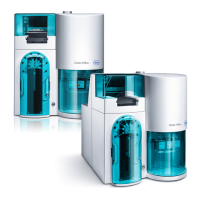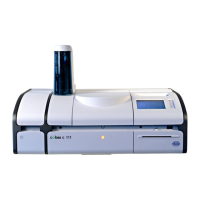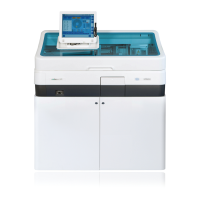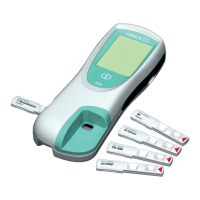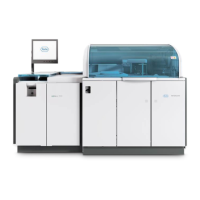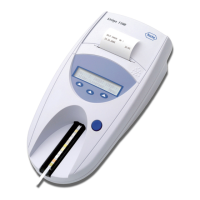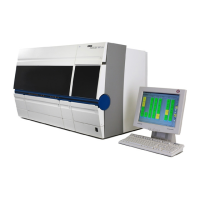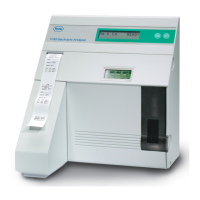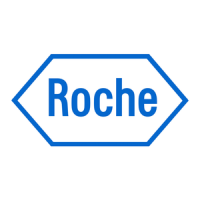
Do you have a question about the Roche Cedex Bio and is the answer not in the manual?
| Manufacturer | Roche Diagnostics |
|---|---|
| Power Requirements | 100-240 V AC, 50/60 Hz |
| Measurement Range | Depends on the parameter measured |
| Connectivity | USB, Ethernet |
| Weight | Approximately 60 kg |
| Operating Temperature | 15-30°C |
| Operating Humidity | 20% to 80% non-condensing |
| Sample Types | Serum, plasma, urine, CSF |
| Type | Automated Clinical Chemistry Analyzer |
| Software | Proprietary Roche software for instrument control, data management, and quality control |
Information about the analyzer's intended use, optimizations, and development.
Describes the analyzer's purpose for determining chemical and biochemical parameters.
Copyright statement.
Lists acknowledged trademarks.
Explains symbols and their meanings for hazardous situations.
Essential information to read and understand before operating the analyzer.
Warns about potential injury from heavy loads during analyzer transport.
Covers electrical shock hazards and grounding requirements for safe operation.
Warns about the danger of eye damage from intense LED light during operation.
Warns about personal injury from contact with analyzer mechanisms.
Emphasizes keeping covers closed and following instructions for safe operation.
Warns about infection risks when handling biohazardous materials.
Warns about infection risks from waste and injury from reagents/solutions.
Warns about risks associated with incorrect installation and environmental conditions.
Warns about data loss from power issues and analyzer malfunction due to EMI.
Warns against using non-approved parts or software to prevent malfunction.
Stresses the need for trained operators and taking breaks to prevent fatigue.
Warns about incorrect results from sample carryover, contaminants, or spillage.
Discusses unauthorized access and data loss risks from malicious software.
Provides guidance on proper disposal and outlines user responsibility for features.
Lists and explains safety labels found on the analyzer.
Shows where safety labels are located on the analyzer components.
Describes the analyzer's intended use, features, and operational requirements.
Explains the absorption photometry measuring method and sample analysis process.
Details the touchscreen layout, tabs, buttons, and global action buttons.
Explains how wizards guide users through tasks, simplifying operation.
Provides an overview of routine tasks for system preparation and monitoring.
Details covers, panels, components, fluid systems, and connections.
Explains software features like screen layout, navigation, and key screens.
Shows removable panels and lids for accessing analyzer parts.
Explains the meaning of LED colors for system status and user actions.
Illustrates and describes the primary hardware components of the analyzer.
Details the fluid system, including rinse station, probe, and fluid containers.
Describes the rotor, reagent disk, and reagent cooler for reagent management.
Explains cuvette segments, handling, and the cuvette ring.
Explains the use of the hand-held barcode scanner for data input.
Describes the built-in thermal printer and its operation.
Details the absorbance photometer and its wavelengths.
Illustrates and labels various input/output connectors on the analyzer.
Locates and identifies the analyzer's mains and low voltage fuses.
Lists physical dimensions, power requirements, environmental conditions, and throughput.
Explains how to operate the analyzer using the touchscreen and introduces wizards.
Details screen layout, tabs, buttons, and other display items.
Explains color coding and how to navigate between screens.
Covers adjusting touchscreen, scrolling, expanding lists, typing, and filtering.
Guides on how to print information from various screens.
Describes how to access and use the context-sensitive online help feature.
Explains how messages and alarms are displayed and how to react to them.
Describes key screens like Overview, Workplace, Utilities, and their functions.
How to delete sample orders and results outside the normal routine.
Covers deleting calibration results and setting up calibration schedules.
How to delete QC results outside the normal daily routine.
Explains viewing, defining, and managing lot data for calibrators, controls, and reagents.
Guides on exporting database, results, and log files to external media.
Details importing application data, software, database, certificates, and mixing rules.
Guides on preparing new disks, assigning tests to tabs, and managing inventory.
Instructions for refilling printer paper and removing condensation water.
Guides on replacing the probe and connecting/disconnecting fluid containers.
Instructions for adjusting and cleaning the touchscreen interface.
Explains how to define the system's working environment and user responsibilities.
Covers importing, installing, activating/deactivating, preparing, and deleting applications.
Defines test processing order and how to manually define ratio applications.
Explains defining profiles, adding/removing tests, and control definitions.
Guides on defining calibrator lots and handling lot data.
Provides reference for application definitions like version, code, and general settings.
Explains calibration parameters and control definitions for ISE and general use.
Details calculation definitions, ratio applications, and result unit conversion.
Covers workflow, host communication settings, and result handling.
Explains defining users, managing access rights, and deleting users.
Explains calculations and checks for photometric measurements.
Details absorbance calculations, blank correction, and volume correction.
Explains rate calculations, calculation models, and reaction direction.
Explains different calibration modes like Linear Interpolation and Linear Regression.
Details result calculation for various modes and associated checks.
Explains volume correction, compensation, and correlation corrections.
Explains QC process, methods, precision criteria, and control checks.
Explains calculations and checks used in electrolyte measurements.
Details slope calculation, range checks, and Sol 1 factor checks for ISE.
Explains calculation of concentration and associated checks for ISE measurements.
Explains maintenance importance, scheduling, intervals, and ensuring smooth operation.
Guides on how to perform maintenance actions, checking due dates, and interpreting colors.
Lists maintenance actions and their recommended frequencies.
Step-by-step guide to deproteinize and manually clean the probe.
Instructions for priming fluid system and cleaning water/waste containers.
Instructions for replacing the water inlet filter.
Step-by-step guide to clean and disinfect the analyzer housing.
Restores the database to optimum condition, typically for performance issues.
Guides on how to replace the photometer lamp.
Explains how to initiate preventive maintenance by contacting service.
Guides on performing air/water calibration for the absorbance photometer.
How to initialize the degasser fluid sensor for proper fluid detection.
Instructions for cleaning the rotor and heating channel.
How to recover the database if an error damaged its structure.
Explains how to use and react to system messages and alarms.
Lists and explains result flags, their meanings, and recommended actions.
Provides guidance on handling common exceptional situations and error messages.
Guides on how to react to error messages and provide information to service representatives.
Provides detailed steps for common troubleshooting tasks like printer issues and fuse changes.
Overview of routine tasks for processing tests using the ISE unit.
Lists safety information relevant to ISE operation.
Guides on preparing the system, including external fluid containers and ISE status.
Explains how ISE calibrations and QC handling are integrated.
Explains the process of defining orders for ISE sample analysis.
Guides on monitoring the progress of ISE analysis and checking analyzer status.
Explains how ISE result handling is integrated with the main analyzer.
Explains the periodic main calibration and QC handling for ISE electrodes.
Describes end-of-shift activities specific to the ISE unit.
Guides on replacing ISE fluid bottles, including status interpretation.
Guides on replacing ISE electrodes, including tools and safety.
Instructions for cleaning the ISE tower, both automatically and manually.
Provides an overview of specific ISE maintenance actions.
Lists ISE maintenance actions and their recommended frequencies.
Lists safety warnings relevant to ISE maintenance procedures.
Guides on performing daily prepare actions for the ISE unit.
Steps to activate electrode surfaces with Activator for correct potentials.
Instructions for conditioning ISE tubing with Activator for proper fluid flow.
How to initialize the sensor for proper detection of air in ISE tubing.
Ensures no traces of previous solutions remain in tubing to prevent drift.
Guides on cleaning, etching, deproteinizing, and activating electrodes.
Instructions for automatically cleaning the ISE tower.
Guides on manually cleaning the ISE tower.
How to initialize the ISE unit using Activator for sensors and pump action.
Guides on replacing the ISE pump tubing to ensure proper pump action.
Instructions for replacing ISE unit tubing due to abrasion from valve action.
How to deactivate the ISE unit for extended non-use periods to save fluids and reduce wear.
Emphasizes understanding procedures and observing actions for troubleshooting.
Explains how the user interface informs about unit status via LEDs, buttons, and messages.
Explains how messages are generated and lists safety information relevant to troubleshooting.
Lists general and ISE-specific flags alphabetically with meaning and actions.
Guides on how to react to specific error messages related to ISE unit operations.
Defines technical terms used in the manual starting with letters A through I.
Defines technical terms used in the manual starting with letters L through R.
Defines technical terms used in the manual starting with letters S through W.


